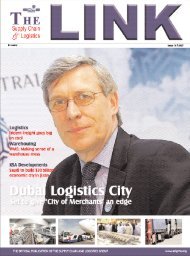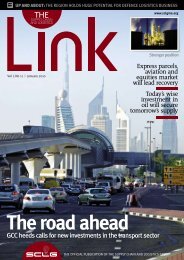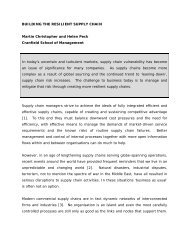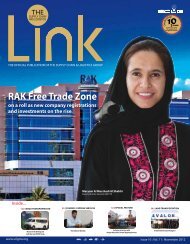Free to Download - SCLG
Free to Download - SCLG
Free to Download - SCLG
- TAGS
- download
- sclg
- sclgme.org
Create successful ePaper yourself
Turn your PDF publications into a flip-book with our unique Google optimized e-Paper software.
China’s economic growth has led<br />
<strong>to</strong> massive expansion across all<br />
consumer categories as its citizens<br />
become more affluent, and, in many cases,<br />
have discretionary income for the first time.<br />
But one sec<strong>to</strong>r stands out for growth even<br />
in China: au<strong>to</strong>mobile sales. Over the past<br />
five years, China was the only country in the<br />
world <strong>to</strong> achieve annual growth of more than<br />
20%, and in 2010 alone, car sales will likely<br />
grow by 23%, according <strong>to</strong> Nielsen estimates.<br />
The big s<strong>to</strong>ry, however, is not the size of<br />
that growth—sales of cars will consistently<br />
increase for the next few years—but where<br />
that growth is coming from: China’s lower tier<br />
cities. These and other issues facing China’s<br />
au<strong>to</strong>motive industry were addressed <strong>to</strong>day<br />
by a range of speakers at the Nielsen China<br />
Forum.<br />
Shirley Ng, Direc<strong>to</strong>r, Client Leaders,<br />
Au<strong>to</strong>motive, The Nielsen Company, China,<br />
spoke of the challenges and opportunities<br />
for car manufacturers and retailers. “Private<br />
vehicle ownership is still low in China and<br />
we expect that the number of first-time<br />
car buyers will increase sharply in the<br />
next few years. Car owners in first tier<br />
cities like Shanghai are starting <strong>to</strong> trade<br />
up—good news for luxury models. But the<br />
real opportunity is in the tier two, three and<br />
four cities such as Shandong, Fujian and<br />
Guangdong, where the middle class is<br />
growing every year and their confidence as<br />
consumers has been rising faster than in tier<br />
one cities.”<br />
Ng said manufacturers and retailers<br />
must understand the differences between<br />
the needs of consumers in lower tier cities<br />
compared with those in tier one cities, and<br />
noted that advertisers must approach these<br />
price sensitive car buyers creatively by<br />
focusing on brand building for the long-term.<br />
To better understand these new car<br />
consumers, Georgia Zhuang, Direc<strong>to</strong>r,<br />
Consumer Research, The Nielsen Company,<br />
China, provided an in-depth look at this group<br />
and the fac<strong>to</strong>rs and themes that drive their<br />
purchase decisions. Lower tier consumers<br />
tend <strong>to</strong> be older than those in tier one, and<br />
their families are their <strong>to</strong>p priority. Work is<br />
viewed as a way <strong>to</strong> increase their family’s<br />
quality of life and they tend <strong>to</strong> have fewer<br />
financial pressures. In short, they have<br />
positive outlooks on life and are confident<br />
about their futures.<br />
Au<strong>to</strong> manufacturers and retailers need <strong>to</strong><br />
market <strong>to</strong>ward these consumers by finding<br />
Au<strong>to</strong> Industry<br />
Chinese Au<strong>to</strong><br />
Industry Racing<br />
Forward<br />
New opportunities for long-term growth<br />
come from lower tier cities<br />
the emotional linkage with their priorities<br />
and satisfying their basic needs. Zhuang<br />
noted that companies focusing on lower<br />
tier consumers would do well <strong>to</strong> emphasize<br />
fundamental themes such as economical,<br />
durable, safe, reliable, simple and plain<br />
exterior <strong>to</strong> consumers. It’s also necessary <strong>to</strong><br />
build a trustworthy brand image that offers<br />
high value.<br />
Since these consumers have little<br />
experience with or knowledge about cars<br />
(90% are first-time buyers) and have limited<br />
information, their purchase decision making is<br />
relatively simpler and quicker. Manufacturers<br />
and retailers should use a range of media<br />
including the Internet and social media as<br />
well as physical displays at various locations.<br />
Dealer network expansion and training of<br />
the sales and service associates will further<br />
enhance brand visibility and reputation—key<br />
fac<strong>to</strong>rs important <strong>to</strong> lower tier consumers.<br />
Mirroring the growth in car sales in China<br />
REAL REPORT<br />
has been advertising spending. From 2009-<br />
2010, the au<strong>to</strong> industry posted the highest<br />
growth in spending of any industry, up 24<br />
percent and indicative of the increased level<br />
of competition between manufacturers.<br />
But that high level of spending has led <strong>to</strong><br />
decreased efficiency in mature markets<br />
whereas lower spending in lower tier markets<br />
has yielded strong results.<br />
Given this marketing environment,<br />
Kenneth Tan, Associate Direc<strong>to</strong>r, Analytical<br />
Consulting, The Nielsen Company, said<br />
that car makers need <strong>to</strong> focus on long-term<br />
growth by consistently advertising <strong>to</strong> build<br />
brand equity. “Marketing helps build market<br />
share in the near-term, but also helps grow<br />
brand Equity in the longer term. Without<br />
incremental activities <strong>to</strong> bring in new buyers<br />
and respond <strong>to</strong> competitive activities, brand<br />
equity will erode. ”Based on Nielsen research,<br />
Tan noted that up <strong>to</strong> 35 percent of <strong>to</strong>tal au<strong>to</strong><br />
sales are based primarily on brand equity.<br />
January 2011 Link<br />
41

















